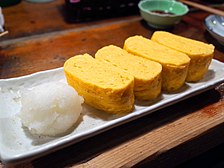Makiyakinabe

Makiyakinabe are square or rectangular
Etymology
Several names are used to refer to the pan, such as makiyakinabe (巻き焼き鍋),[1] tamagoyaki-ki (玉子焼き器),[2] and tamagoyakinabe (玉子焼き鍋).[3] Occasionally, the implement is simply referred to as a Japanese omelette pan.[4][5] The term makiyakinabe derives from the Japanese words maki (巻き), meaning "roll", yaki (焼き), which is an umbrella term for "cooking over heat", and nabe (鍋), which means "pan". The terms tamagoyaki-ki and tamagoyakinabe both refer to the rolled omelettes that are typically made with the pan, with ki (器) meaning "implement" in the former phrase.
Design and use
In Japanese cuisine, makiyakinabe pans are used for making sweet or savory tamagoyaki,[10] sometimes called dashimaki tamago when dashi is used,[11][a] or usuyaki tamago (thin, one-layer omelette).[14]
A tamagoyaki dish starts as a single layer of rectangular omelette,
The pan must be slicked with only a very thin coating of oil.
Some recipes caution that the egg should not be allowed to brown at all,
Tamagoyaki

The rolled omelette made in makiyakinabe can be used as a topping for
Varieties of the omelette depend on its thickness. Thinner varieties are used as garnishes or as wrappers which are formed into pouches that are filled with sushi rice. Thicker omelettes are more common and are used for nigirizushi and
Tamagoyaki can be eaten as a snack, side dish,[15] or breakfast food.[23] The omelettes are a common inclusion in bentō boxes.[20]
See also
- List of Japanese cooking utensils – utensils of similar Japanese origin
Explanatory notes
- ^ When the dish is called dashimaki tamago, this often means it is savory or less sweet.[12] Even though some literature intimates that the dish is automatically called dashimaki whenever dashi is used, in actuality, the dish is not precluded from being called tamagoyaki whether it uses dashi (or not).[13]
- ^ The first layer might use just one third of the egg mixture,[10] or just 10%.[15]
- ^ Recipes may call for molding the cooked tamagoyaki by wrapping it within a makisu (sushi mat),[15][16] but that detail is beyond the scope of the subject.
References
Citations
- OCLC 961457729.
- OCLC 841339613.
- )
- OCLC 805858293.
- OCLC 154800158.
- ^ OCLC 792687332.
- OCLC 60373773.
- OCLC 993292976.
- ^ a b "Tamagoyaki Japanese rolled egg". Chopstick Chronicles. 29 May 2018. Archived from the original on 2 June 2019. Retrieved 2 June 2019.
- ^ ISBN 9781844301812.
- ^ OCLC 318878336.
- ISBN 9789814771641.
- ISBN 9781462903436.
- ISBN 9784533004568.
To make usuyaki-tamago the Japanese way, you need.. tamagoyaki-nabé
- ^ OCLC 944314190.
- ^ ISBN 9780761183068.
- ^ Shinojima, Chū 志の島忠 (1984). Kaiseki ryōri 会席料理 (in Japanese). Vol. 1. Fujingahōsha. p. 130.
- ^ Khong (2017), p. 63.
- ^ "Oishī! Nenmatsu no Tsukiji de ninki no tamagoyaki 4ten wo tabekurabe shitemita" おいし~!年末の築地で人気の「玉子焼き」4店を食べ比べしてみた. The Japan Times Online (in Japanese). 28 December 2014. Archived from the original on 2 June 2019. Retrieved 2 June 2019.
- ^ from the original on 2 June 2019. Retrieved 2 June 2019.
- ISBN 9781942993285.)
{{cite book}}: CS1 maint: location (link - OCLC 962114405.
- ISBN 9784255920368.
Bibliography
- Khong, Rachel (2017). Lucky Peach All about Eggs. editors of Lucky Peach. Crown Publishing Group. pp. 62–65. ISBN 9780804187756.
